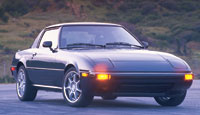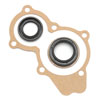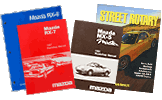Transmissions

Transmission Specifications
Since 1974, Mazda has offered five distinct manual transmission gear cases. While the bell housing-to-rear side housing bolt pattern is the same on all five configurations, and the input shaft pilot bearing is the same on all five model configurations, caution must be exercised when swapping transmissions between various year engines - the starter motor "pilot" diameter in the bell housing did change several times. Also, the input shaft’s spline section on the 1987-95 turbo transmission is larger than its non-turbo counterparts. The "ribbed" transmission gear case was included on all 1974-78 U.S. rotaries and could be easily identified by the external ribbing on the case and the six mounting studs/nuts that attached the case to the bell housing. These transmissions were offered during this time first as 4-speed units and later as 5-speed units. While the basic gear assembly was strong, the synchro rings were somewhat fragile.
The "smooth" transmission gear case, named for the absence of external ribbing, was utilized on all 1979-92 non-turbo chassis. These transmission cases were both lighter and stronger than that of the previous generation. The smooth gear case was integrated with the bell housing, making removal of the bell housing impossible.
In 1987 Mazda again introduced a "ribbed" gear case that was utilized in all 1987-95 Turbo chassis. This ribbed gear case, identified by its 23 tooth spline input shaft (as compared to the previous generations 22 tooth spline), and the removable bell housing attached with 8 mounting studs/nuts, has proven to be a very strong gear case. It is not uncommon to find this assembly retro-fitted into earlier RX-7 chassis, utilizing our 225mm race clutch discs (either 4 or 6 puck) with a turbo spline hub.
The RX-8 also has a "smooth" case with integral bell housing - but it has 6 speeds. It is a new model and uses the "turbo" ring gear and "turbo" spline.
If you plan to use a stock transmission extension housing in a sustained high speed road racing application, the stock driveshaft yoke is likely to wear badly on the extension housing bushing. The primary cause is lack of adequate oil around the bushing to cool the housing. As a result, the extension housing will expand from the heat, the bushing may spin in its bore, the rear seal will pop out, and then the transmission oil will leak out.
Later non-turbo driveshafts, which had non-replaceable joints, may be replaced with earlier shafts or modified to utilize replaceable joints.
Manual Transmission Ratios
| 71-76 | 77-78 | 79-83 | 84-85 | 1986 | 87-92 | 87-91 TII | 93-95 | RX-8 | |
|---|---|---|---|---|---|---|---|---|---|
| 1st | 3.683 | 3.380 | 3.674 | 3.622 | 3.475 | 3.475 | 3.483 | 3.483 | 3.760 |
| 2nd | 2.263 | 2.002 | 2.217 | 2.186 | 2.002 | 2.002 | 2.015 | 2.015 | 2.269 |
| 3rd | 1.397 | 1.390 | 1.432 | 1.419 | 1.366 | 1.366 | 1.391 | 1.391 | 1.645 |
| 4th | 1.0 | 1.0 | 1.0 | 1.0 | 1.0 | 1.0 | 1.0 | 1.0 | 1.187 |
| 5th | .862 | .791 | .825 | A* | .711 | B* | C* | .719 | 1.0 |
| 6th | .843 |
A* - 1984 12A (.758), 1984 13B & 1985 12A (.807), 1985 13B (.711)
B* - 1987-92 (.697), 1989-90 with LSD (.756)
C* - 1987-88 TII (.762), 1989-91 TII (.719)
Transmission Synchronizer Ring Tips
Before the introduction of the RX-7 transmission in mid-1978, Mazda’s pre-RX-7 transmissions had a well-deserved reputation for being nearly unbreakable except for the synchronizers. Synchro life varied drastically, depending on the skill and technique of the driver, but generally ended up in the 20,000 to 40,000 mile range. Second gear was the usual problem, but all the others could readily fail as well. Such failures, which result in grinding the synchro teeth when shifting, were frequently brought on by just one missed shift! Therefore, full clutch release and smooth lever movement are essential.
If you should find your transmission starting to grind when shifting, it should be fixed immediately. The damage to internal parts increases rapidly with continual use. One of the primary reasons for this grinding is that the "synchronizer rings" are especially weak in pre-RX-7 transmissions. The three slots cut in the rings to engage the synchro keys weaken the rings so much that any unusual force causes them to bend at the slots, and once they distort, replacement is the only answer. There is no "better" synchro ring for the pre-RX-7 transmission, although Mazda did make a number of detail design changes over the years. When replacing transmission parts, be sure to use the correct parts for your particular year, model, and chassis number.
When rebuilding a transmission, it is helpful to "lap in" all the new synchro rings against the old gears. This process breaks the glaze on the old gear "cone" and reduces the chance of hard shifting, as well as the attendant risk of bending the rings. This lapping is accomplished by rotating the ring against the gear with fine valve-lapping compound in between for 20 to 30 seconds. All the same cautions apply to the RX-7 transmission, but to a lesser degree, since the RX-7 synchro rings have only partial "slots." These rings are not interchangeable with those of earlier transmissions.
To improve synchro life and reduce wear, we recommend a change to a synthetic gear lube after break in. The results are immediate and impressive.
Transmission Maintenance
Whenever the transmission is removed several "preventative maintenance" steps should be performed.
First, lightly lube all the pivots on the clutch fork with heavy grease. Next, inspect the throwout bearing for roughness in the bearing: push in on the bearing when checking it. If there is any doubt as to its condition, replace it with a Mazda stock part. These stock components are very durable; however, if you run out of "free play" on the slave cylinder pushrod the bearing may prematurely fail. This problem can usually be identified by deep grooves worn in the pressure plate diaphragm spring fingers. Wipe a bit of heavy grease into the recess inside the throwout bearing so that it will slide easily on its guide.
Always change the transmission front seal (and gasket when applicable) any time the transmission has been removed and replaced. In our experience, when a transmission is removed, the input shaft tends to hang up temporarily on the eccentric shaft. This distorts the front transmission seal slightly and can cause leakage. While the same replacement recommendation applies to the rear transmission seal this item can be replaced with the transmission in place with a minimum of trouble.
On two occasions, cars with "scratchy" transmission synchronizers were completely cured by a change to synthetic gear lube. But, because of the reduced friction, the time necessary to "break in" a transmission, or limited slip differential (standard differentials are no problem) is excessively long, so we recommend using mineral oil for a time to ensure rapid "break in".
Copyright 2007-2024 Racing Beat, Inc ©
 All Years Available
All Years Available





